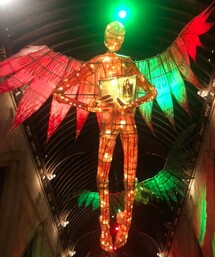
 In essence, Christmas is quite a queer thing - don’t you think? I don’t really mean its added oddities, like the 19th century, mainly English, extras, like the carols we sing, and the 20th century, mainly American, extras, like the exaltation of Santa. Those are aspects of Christmas down under which are part of our eclectic multiculturalism, even if they partly reflect our settler colonial culture and tend to work better in the northern hemisphere. For we have more than a little work still to do in listening to the Spirit in these lands now called Australia, including turning many of Christmas traditional symbols upside down and inside out. But that is less of a challenge when we truly celebrate the queerness of Christmas, especially in its original, biblically recorded, forms. For the stories of Christ’s birth - God made flesh - are, like queerness, full of extraordinary features, and very difficult to pin down. Indeed, the very idea that God is made flesh was, and is, a horror to many people. That means that matter matters, and, not least, our bodies matter – and every little bit of them – and caring for one another and our planet matters, because ‘matter matters’ and everything shares in this divine matter. Meanwhile, the idea that God is born in, and with, marginal and outcast bodies still seems so absurd and objectionable to many. For the biblical stories and symbols present God’s queer love: the ultimately irresistible power of Love which overturns all the neat boxes and boundaries of our oppressive world, and its typical ways of thinking. So, rather than trying to straighten out Christmas, as many people try to do every year, I believe that we are far better simply to enjoy its very queer ride: which involves keep adding to the oddities of this time of year, with fresh joy and creativity; and letting its divine queerness shine in us…
0 Comments
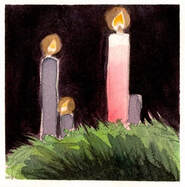 I imagine many of us know the old Gospel campfire and children’s song ‘I’ve Got That Joy, Joy, Joy, Down in My Heart.’ The tune itself is upbeat, catchy, and hard to forget. We might even try singing it now, perhaps responsorially: I’ve got that joy, joy, joy, down in my heart Where? - Down in my heart? Where? - Down in my heart to stay. The song has other verses too, including having ‘the peace that passes understanding’. One version also has one verse about dealing with spiritual distress. It goes like this: If the devil doesn’t like it, they can sit on a tack Ouch! - Sit on a tack Ouch! - Sit on a tack today Of course, the song is hardly great poetry. It does however reflect the great spiritual gift of Joy which we celebrate today, and which is central both to Mary and the story of Jesus’ birth, and to the spiritual life as a whole… 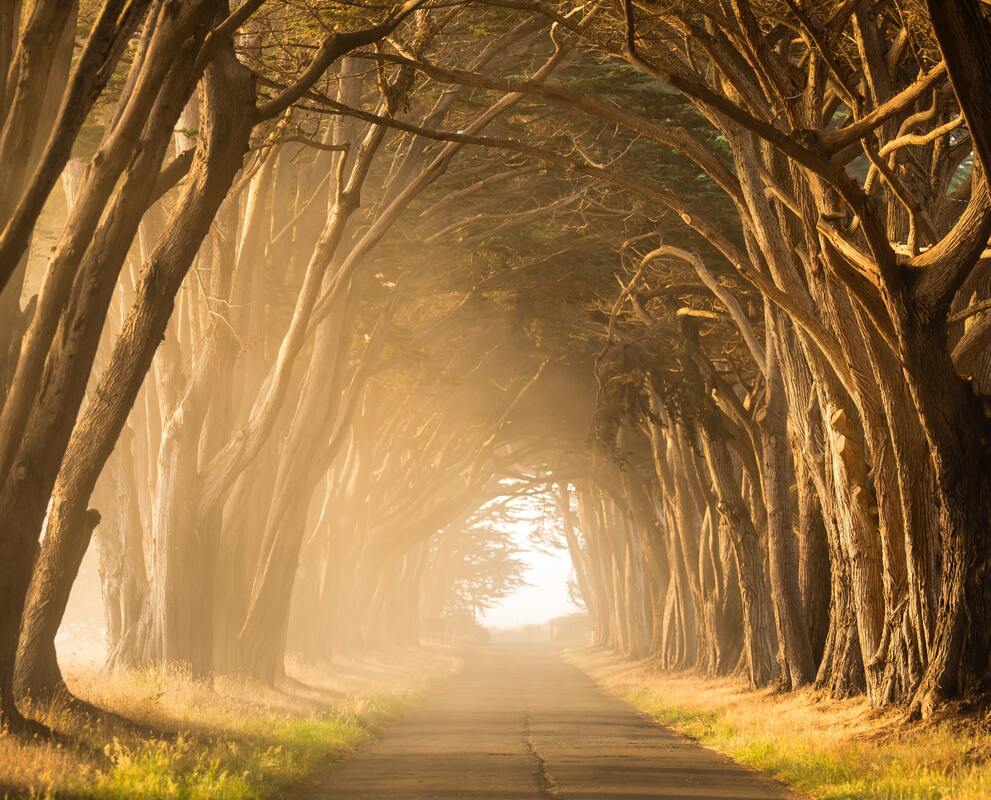 image: Stephen Leonardi on Unsplash image: Stephen Leonardi on Unsplash Our Gospel readings this week and next relate to what has traditionally been termed ‘the call’ of Jesus. Like the often very institutional church calls to ‘mission’, about which I spoke a fortnight ago, this call can often be interpreted quite narrowly, even oppressively. Indeed, it has sometimes been treated as a demand. Yet, in reality, as we see in both this week and next week’s Gospel’s reading, the call of Jesus is not so much a demand as an invitation. It seeks, as I said a fortnight ago, to draw us not drive us: to draw us into divine love and new life, not drive us into anything else, however admirable. For note well Jesus’ specific words in today’s reading from John’s Gospel: ‘come and see’. Like the words ‘follow me’ in Matthew’s Gospel next week, whilst Jesus invites, there is no compulsion. Nor is particular direction or content provided, although the Gospel record provides us early Christian understandings. Rather the invitation is primarily to an adventure of faith and experience. There is no requirement of belief as such, though that might emerge to give expression to the experience of the journey. There is no clear timetable, shape or schedule, or obvious destination. Jesus simply calls on those who will to set out on a shared pathway, walking together in trust. Is that how we see faith today?... 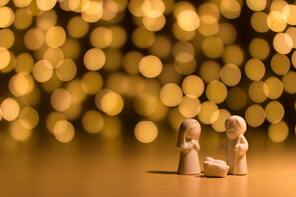 image: Gareth Harper on Unsplash image: Gareth Harper on Unsplash I want to begin by inviting you to look up - Look – here! at this trinity of angels, symbolising Courage, Compassion and Joy. Jyllie Jackson, the artist who with her team created them, saw these as qualities particularly embodied – incarnated indeed – here in our community at Pitt St Uniting Church. Those of us who worship here regularly – can we see ourselves I wonder? It is hard sometimes to see ourselves as others see us! And those of you visiting here today – I wonder what aspects of yourselves you see here in our angels? For they are icons of incarnation... Courage - Compassion – Joy: these are the name of the angels we have, above us, this evening. Courage – Compassion – Joy: gifts of grace which our church community, with others, seeks to share at World Pride here in Sydney next year, and at all times. For Courage – Compassion – Joy: which of these, I wonder, do each of us need at this time, for ourselves, or for others? May these gifts truly enrich us, for they take us to the heart of our celebrations this evening: the very presence of God in humanity, in human birthing. As such, they are pointers to the deepest reality of our lives. As we see the angels above us, see and share light among us, and, above all, see and share bread and wine – the symbols of divine humanity in us – so may we know God’s extraordinary Love, within and beyond us. For the various elements of our Christmas celebration proclaim that, as above, so below and all around, between, and in all possible dimensions, the God of Love is born among us. Tonight, in the great Christian narrative, is the hinge of history, the heart of meaning, and the hallowing of human being. Let me briefly touch on three elements. For the Christian Christmas is a truly extra-ordinary happening, and a profound embodying, which is also ‘not quite nice’…
Christmas-time is so often a confluence of loss and gain. So many of us find that good and tough memories are tangled up. My parents died a year ago this weekend, just as a new child was conceived in my immediate family: a child who will therefore be a new gift among us this Christmas. Yet it is hardly the first time that death and birthing have been entwined. Reflecting on that helps me better understand today’s Gospel and not least Mary’s extraordinary cry of justice, and of joy. As Alla Renee Bozarth brilliantly expresses it in her poem Annunciation, it is a cry of subversive angelic power. No wonder the three large ‘queer’ angels we will shortly welcome from Lismore’s LIghtnUp project are entitled Courage, Compassion, and Joy. For, as Lismore’s wonderful community artist Jyllie Jackson has identified, Courage, Compassion and Joy are core life-giving elements, not only to Queer Pride. They also, vitally, flow out of the Gospel and Magnificat of Mary, and, as Jyllie suggests to us, they are at the core of what the Way of Jesus, and our particular community, is and can be…
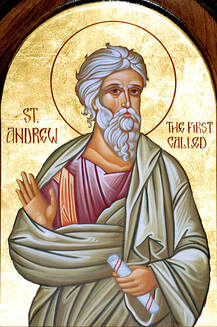 It is one of those lovely quiz questions, isn’t it – what do Barbados, Romania, the Ukraine and Scotland have in common? The answer is St Andrew of course, as their shared patron saint. In this COVID-19 year, that is something for which it is particularly important to wonder and give thanks. For in recent months we have, as a world together, been both divided by border closures, and united in suffering. On this Advent Sunday therefore, it is good to be reminded of our even greater connections in the immense hope to which St Andrew responded and shared with others. For Andrew’s witness is not least to the central importance of relationships, with God in Jesus Christ, with one another, and with the wider world. Today, as we celebrate the feast of St Andrew, and Advent hope, it is into such mission into which we too are called, and the joy which lies in such relational hope, beyond all the divisions and sufferings of our lives and world. Thus St Andrew should empower us to trust, and find new life, across our human borders and in the borderlands of suffering and joy, despair and hope… 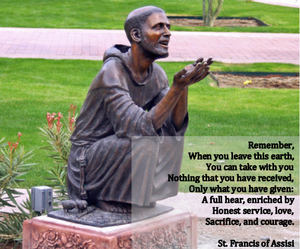 One of the names I was given when I was born was Francis, in its masculine form. So, over several years, I pondered it. well.Today it is not one of my legal names. However it is still very valuable to me. According to the dictionary it means, particularly in its Latin form ‘Frenchman’, which is a lovely little challenge of inclusion for some of us brought up with centuries of conflict and xenophobia between England and France. In its Teutonic, and American usage, it also however means ‘Free’, which seems particularly life-giving to me, and certainly one beautiful way of considering our little brother Francesco, St Francis, the patron site of this college and its site. So what are the features of this freedom which Francesco lived and encourages in us? What difference may walking with St Francis make to us and our world today?... As so often when we come to a saint even of national significance like David, the preacher finds themselves saying, ‘we really do not know very much about them, and what we do know seems to be the stuff of legends’. So indeed we know very little for certain about St. David. He was born in 520 and legend has it that his mother was a nun, who was raped by one of the local princes and David was the consequence. Not a particularly auspicious beginning. However the faith of his mother seems to have communicated itself to David, who lived the life of simple monk, eating sparsely, often just leeks, bread and water, and never touching alcohol, which earned him the title the ‘waterman’ as he drank just water...
 As you may be aware, there is a tradition in more Catholic Christian circles of using rose pink as a colour for this Sunday. For the third Sunday of Advent has often been known as “Gaudete’ – or ‘Rejoice’ – Sunday, and rose pink, became linked to it, as rose pink is also associated with Mary the Mother of Jesus. So, being a bit into colours at the moment, especially pink ones, I thought I’d do a little investigation into the subject. The first thing I came across was the Readers Digest guide to rose colour meanings It begins very interestingly. The red rose is said to symbolise love, and, I quote, is ‘Perfect for: freaking out your first date; covering beer stains; wooing a hunky bishop.’ So, something to bear in mind there? In contrast, according to Readers Digest, the pink rose is said to express grace and elegance, as well as sweetness and sympathy: and thus: ‘Perfect for: sick secretaries, (and) the platinum blonde in your life.’ Again, is there something useful for us to remember there? Well, maybe just a teens-weensy bit of gender stereotyping in that, don’t you think?! It is a little like many approaches to Mary, the Mother of Jesus … |
Authors
sermons and reflections from Penny Jones & Josephine Inkpin, a same gender married Anglican clergy couple serving with the Uniting Church in Sydney Archives
June 2024
Categories
All
|
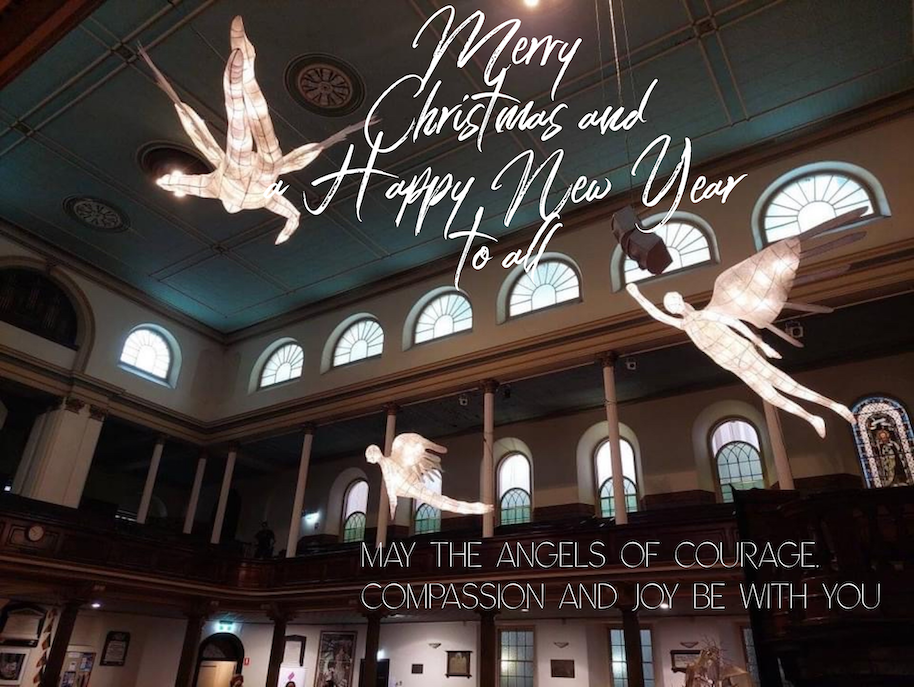

 RSS Feed
RSS Feed